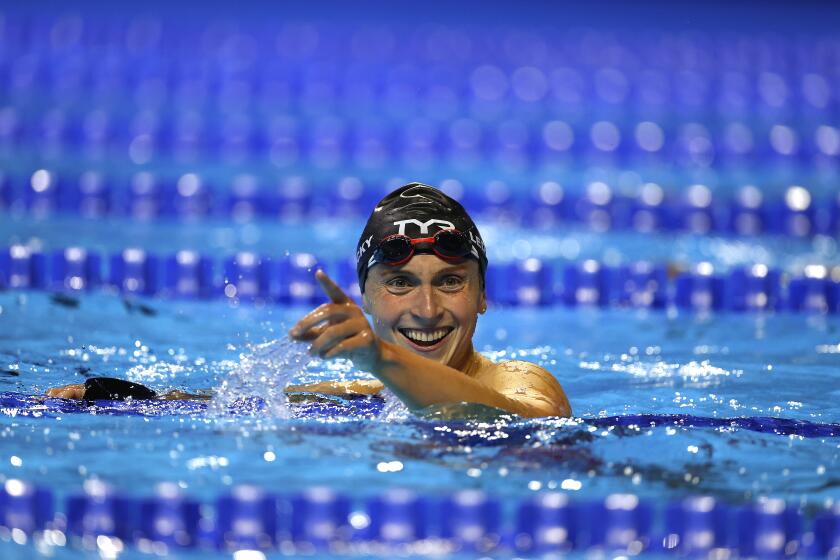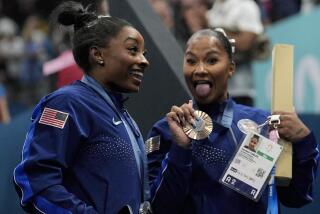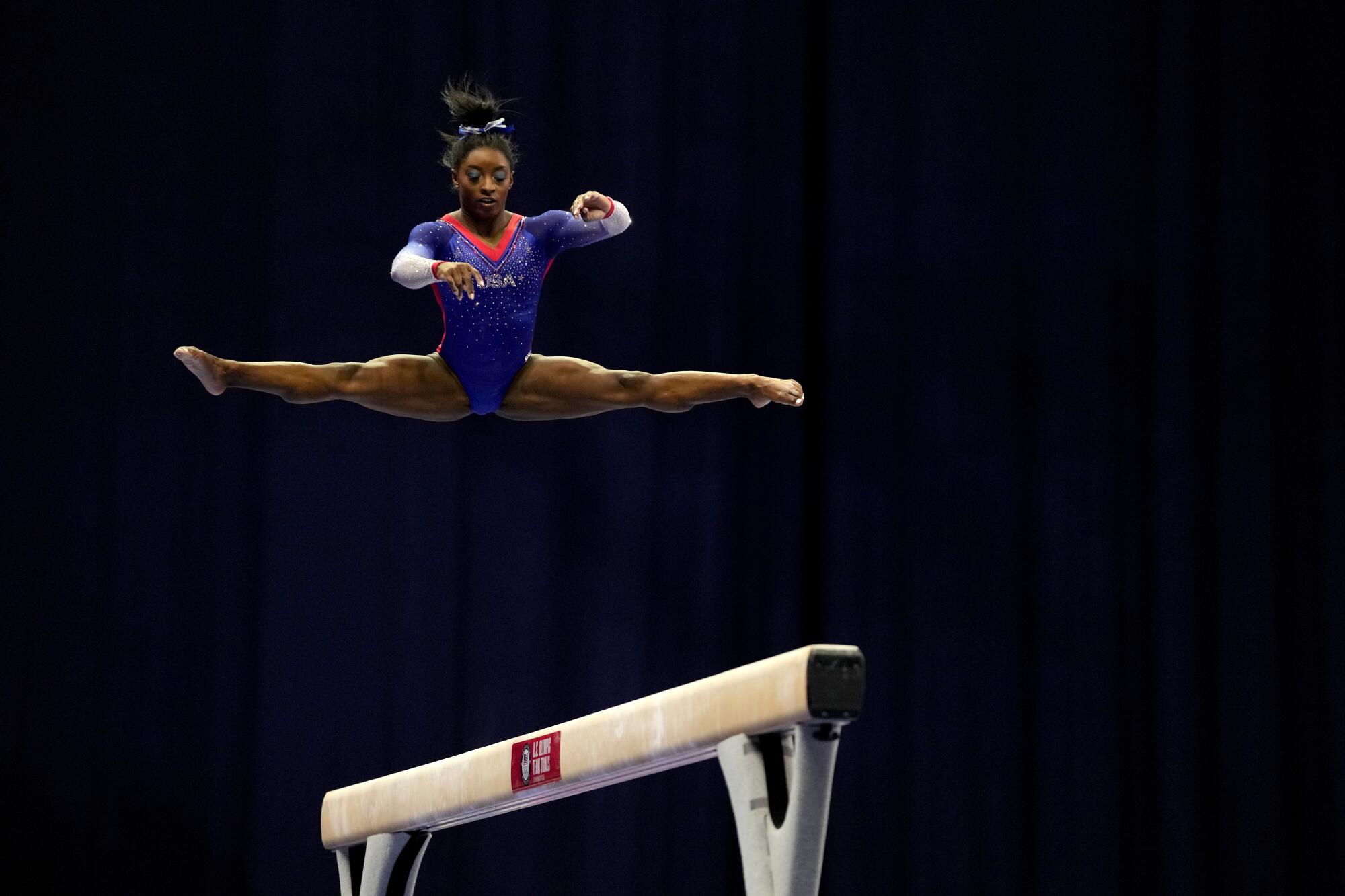
- Share via
To watch Simone Biles soar so high off the vault table that she nearly kisses the sky, twisting and flipping an absurd number of times before gravity peevishly reclaims her, is to wonder if your eyes truly saw things your brain insists can’t possibly have happened.
What did she just do? How did she do that?
She is a five-time Olympic medalist and owner of more gold medals at the world championships (19) and total world medals (25) than any other gymnast, feats that would secure her legacy without question. But when the Tokyo Olympics were delayed a year, she challenged herself to pursue a second straight all-around title by conjuring and conquering moves that pushed her to heights no other female gymnast has touched.
In May, she became the first woman to land a Yurchenko double pike vault, which calls for a roundoff onto the springboard, a back handspring onto the vault, and two backflips with her body folded and her legs straight. Because of the pandemic, it was her first competition in 18 months. She aced it.
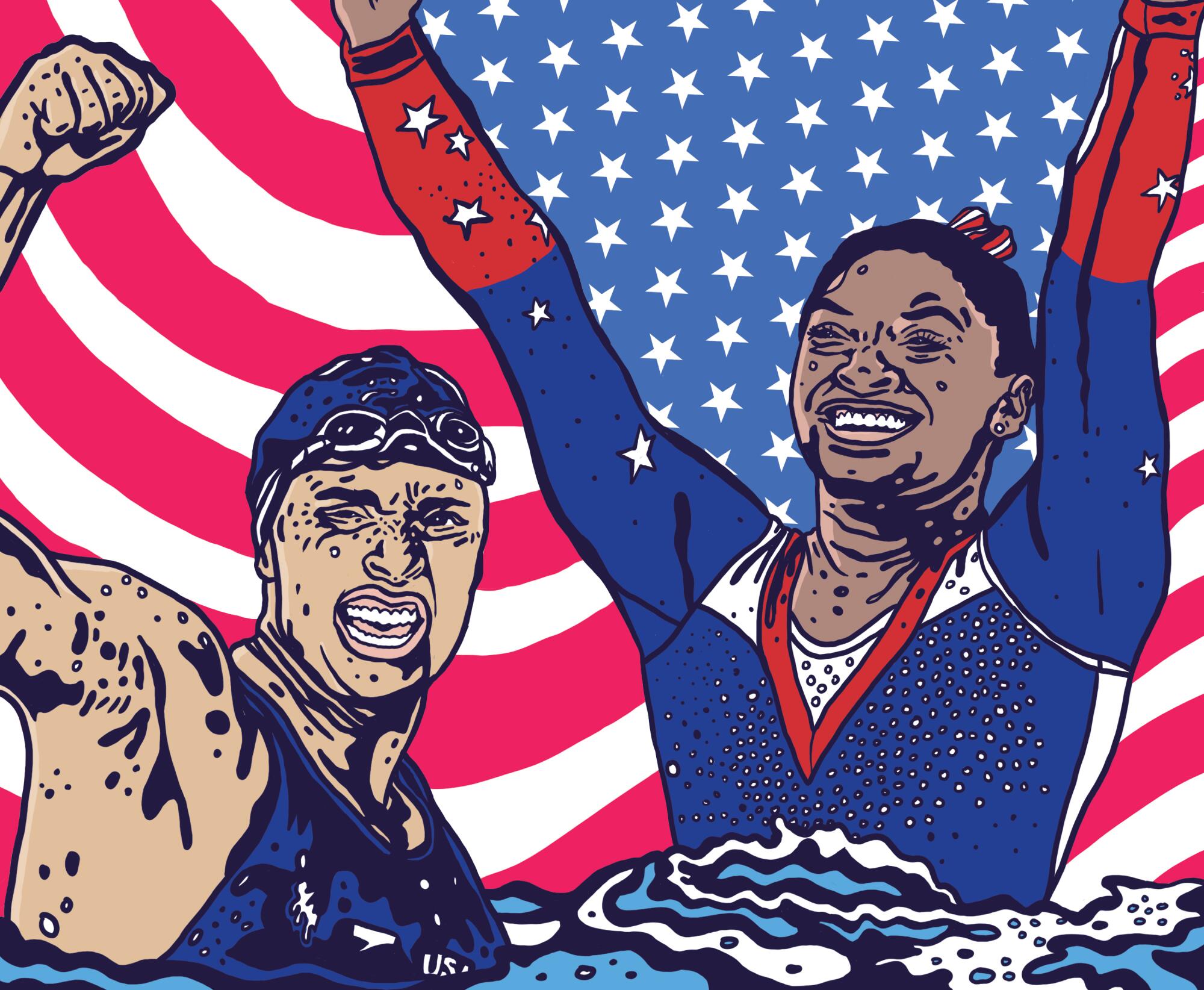
Easing back into things isn’t her style. Nor is settling for doing something well if she can do it spectacularly.
Biles, 24, thought she was done after she won four gold medals and a bronze at the 2016 Rio Olympics. After taking a year off she realized she still could make the impossible become real and elevate the sport.
“I think that when somebody’s striving for perfection and doing harder skills, it pushes other athletes to know that it’s possible and that they can do it, too,” she said after she won the all-around title at the U.S. Olympic trials and affirmed her berth on the Tokyo team.
“I would say we have reached a point where gymnastics is getting more difficult and more difficult and a little bit more dangerous so we’re kind of walking on eggshells here, but it’s exciting to watch.”
The International Gymnastics Federation (FIG in its French acronym) gave the Yurchenko double pike vault a difficulty value of 6.6, too low given its difficulty. FIG supposedly wants to discourage other women from attempting it and risking injury, but the effect unfairly penalizes Biles for being better than everyone else.
Subscribers get early access to this part of our Tokyo Olympics coverage
We’re offering L.A. Times subscribers first access to our preview of the 2021 games. Thank you for your support.
At 4-foot-8, Biles stands tall among the best of the best and is an overwhelming favorite in Tokyo to become the first woman to repeat as all-around Olympic champion since Vera Caslavska of Czechoslovakia triumphed in 1964 and 1968. Tokyo is almost certainly Biles’ Olympic finale as an all-around competitor, though she hinted earlier this year she might compete in a couple of events at the 2024 Paris Games because her French-born coaches, Cecile and Laurent Landi, “have guilted me into at least being a specialist and coming back.” For now Tokyo is her focus and she’s poised to leave a glorious golden imprint on an Olympics that will largely be sapped of joy by COVID restrictions and will unfold without the crowds she deserves to have cheering for her.
“She’s like a rocket shot to the moon on vault,” said Kathy Johnson Clarke, who was captain of the 1980 and 1984 U.S. women’s Olympic gymnastics teams and a double medalist at the Los Angeles Games.
“Her proportions are perfect for the sport of gymnastics, when you can be that tiny in stature and that strong,” said Johnson Clarke, an analyst for the SEC Network. “The combination of her size and her relative strength — because it’s strength-to-weight ratio — is huge for her, but it’s not just that. She’s so powerful. She’s so quick. Springing. All of the adjectives. I’m a commentator, so I come up with words, but I have to make up new ones for Simone.”
There are many reasons the bedazzled goat (for Greatest of All Time) Biles has worn on her leotard was an example of truth in advertising and not a gimmick.
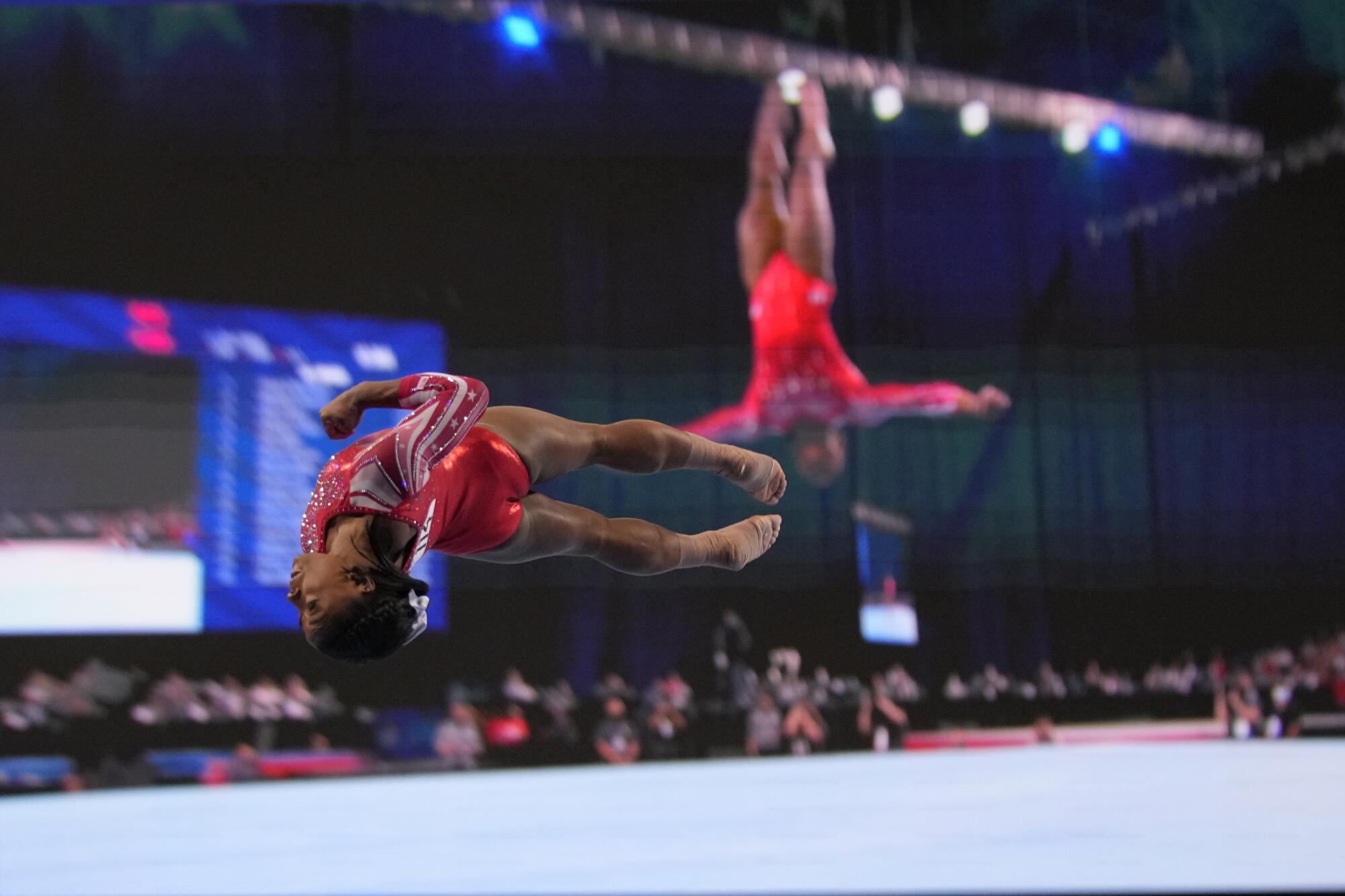
Start with her strong, muscular legs.
“Three of the four events for women are primarily tumbling — floor, vault and beam. And if you’re a powerful tumbler you’re already great on three events,” said Bart Conner, a gold medalist in the men’s team and parallel bar events at the 1984 Olympics and a three-time world medalist.
“With the high level of difficulty that she can perform with ease, she has basically made herself unbeatable. She enters nearly every meet with two to three points more in difficulty than everyone else. In a way, she’s a perfect gymnast for the perfect time because there’s a premium right now in the scoring on difficulty.”
Biles performs triple doubles (double backflips with three twists) with such ease during her floor exercise routine, tumbling so forcefully that the springy, 40-foot-by-40-foot competition surface often can’t contain her power. Then consider her vault skills. “Her roundoff back handspring is the most technically precise and perfect and effective roundoff back handspring that I’ve ever seen, and that’s a basic element in gymnastics,” Johnson Clarke said. “Children do it in the backyard, so it’s not a difficult skill. It’s the way she does it.

“I have never seen one done so perfectly and then injected with speed, power, pop, everything. The way she pushes off the mat, pushes through her shoulders, the angle, like no angles in the shoulders. A photographer could take a series of shots and freeze frame and you cannot get her in a bad position, an incorrect position.”
She combines that power with exceptional finesse. “Her technique is on point, too. She’s got unbelievably good technique to go with her power,” Conner said. “And that is rare because sometimes you have technicians who just don’t have enough power, or you have powerful athletes that just don’t have the technique. She has both.”
Fans might not understand how she does it but they’re drawn to her fearlessness and they love the drama of guessing which daring move she’ll come up with next. Squealing kids in the stands want to be her. Their parents see a strong, accomplished woman and worthy role model. It doesn’t take a gymnastics expert to recognize a unique artist whose performances should be cherished.
“We have a superhero,” said UCLA gymnastics coach Chris Waller, who got Biles to commit to becoming a Bruin in 2014 before she instead chose Olympic-track competition. “Frankly, I don’t think there has ever been a more dominant athlete, male or female, in any sport in the world. And I will share that years ago I saw her training in practice skills that she wasn’t going to use for three to four to five years. She was that far ahead.”
Katie Ledecky’s seemingly effortless excellence leaves some of the most experienced people in swimming grasping for the secret to her dominance
Biles has had four skills named after her — the ultimate sign of respect in gymnastics — and might expand that list. She and Cecile Landi discussed whether she should add a revolution to her three-revolution wolf turn on the balance beam but left it unresolved because they’re not sure it would be named for her if she pulled it off. “We were like, ‘Okay, if we could get a name, yes, we’ll do four,’ but then we’re just like, ‘Don’t even worry about it,’” Biles said.
She doesn’t have to take big risks, but her competitive nature drives her to challenge herself. That’s another trait shared by great athletes. “She could have won the Olympics with her routine from Rio. And here we are five years later, and she is just pushing the boundaries to the limit that I don’t think anyone every really thought was possible,” said Nastia Liukin, who won the all-around gold medal in 2008 and is now a commentator for NBC Sports.
“She is pushing boundaries for everybody and for the entire sport. That’s totally needed. But if she didn’t do it, that doesn’t take away from the greatness that she is and the legacy that she will forever have left on the sport. But the fact that she is continuing to push those boundaries means a lot.”
Gymnasts are scored on the difficulty of their skills (the D score) and the execution of those skills (the E score). Biles is so far ahead of everyone in the difficulty component that she can fall twice and still win, as happened at the 2018 world championships. She has won every all-around competition she has entered since 2013.
“We have a superhero. Frankly, I don’t think there has ever been a more dominant athlete, male or female, in any sport in the world.”
— UCLA gymnastics coach Chris Waller on Simone Biles
She didn’t attempt the tough Yurchenko double pike vault at the Olympic trials, and she drew gasps from the crowd when she slipped off the balance beam on the second day of competition. She cried after that fall, though there was no harm done and her Olympic berth was locked up. She was upset that she had fallen short of the greatness she routinely expects of herself.
“I feel like anything rather than my best will tick me off just because we had a huge crowd and I wanted to give them my best performance. It’s what they deserve after COVID and the year that we’ve had,” she said. “They came out, they paid for trials tickets. I wish I could have given them a better performance, like I did on Night 1. Unfortunately, that wasn’t the case. Yes, I still made the Olympic team and we got to celebrate, which was super, super fun but it’s just disappointing when I can’t show the crowd exactly what I’ve been training to do.”
Sunisa Lee, a dazzling performer at 18, finished second to Biles and automatically earned an Olympic nomination. Third-place finisher Jordan Chiles, a 20-year-old UCLA commit who trains at Biles’ gym in Texas, and fourth-place finisher Grace McCallum also got team spots. Jade Carey and MyKayla Skinner earned individual specialist berths.
Biles has enjoyed mentoring her younger teammates, and the gym she and her family own, World Champions Centre, has become a magnet for teenage Olympic hopefuls. She enjoys the energy the youngsters bring. “They just keep us on our toes and they just make us realize the love for the sport,” she said, “because we were once in their shoes and it was just so much fun, and it continues to be, no matter how old we are.”
But those kids know she’s still in charge. “Going into a meet it’s like, ‘Simone’s going to win. Simone always wins,’” Lee said. “Going in I’m just competing for second place because I feel like that’s the only place that somebody’s going to get because nobody is going to beat Simone.”
Biles has said she might not attempt the Yurchenko double pike vault at the Olympics until the women’s all-around final because it’s too risky to try during team qualifying or the team competition. If she misses it in the all-around final the consequences fall on her, not the team. The U.S. women’s squad is deep and versatile enough that she won’t have to take that kind of risk in the team competition, anyway.
Biles had hoped the international federation would raise the value of the Yurchenko double pike vault to reflect its difficulty but that doesn’t appear likely. “Of course, we would want it to be a higher value but it’s looking like it’s not going to be, so what are we going to do? Just keep making a fuss about it?” Biles said. “It’s like, I don’t want to be a brat about it. If I can still go out there and do it I’m still going to go out there and do it, regardless of the value that it’s given.”
Only a few male gymnasts have ever landed that vault. No current female competitor can do it, or many of Biles’ other ridiculously tricky moves. No one is likely to catch up soon.
“No, not probably for 40, 50 more years,” said Nadia Comaneci, who earned the first perfect 10 in Olympic history at the 1976 Montreal Games. “If somebody gives me the power that she has, I can figure out in my head how to do those things. But the physique that she has — she’s powerful, she’s strong and she’s fast. Right now I don’t see anybody else.”
Liukin also sees no challengers to Biles’ supremacy. “At the end of the day she is her biggest competition and she knows that and I think we all kind of know that, and I have so much respect for her on so many different levels,” Liukin said.
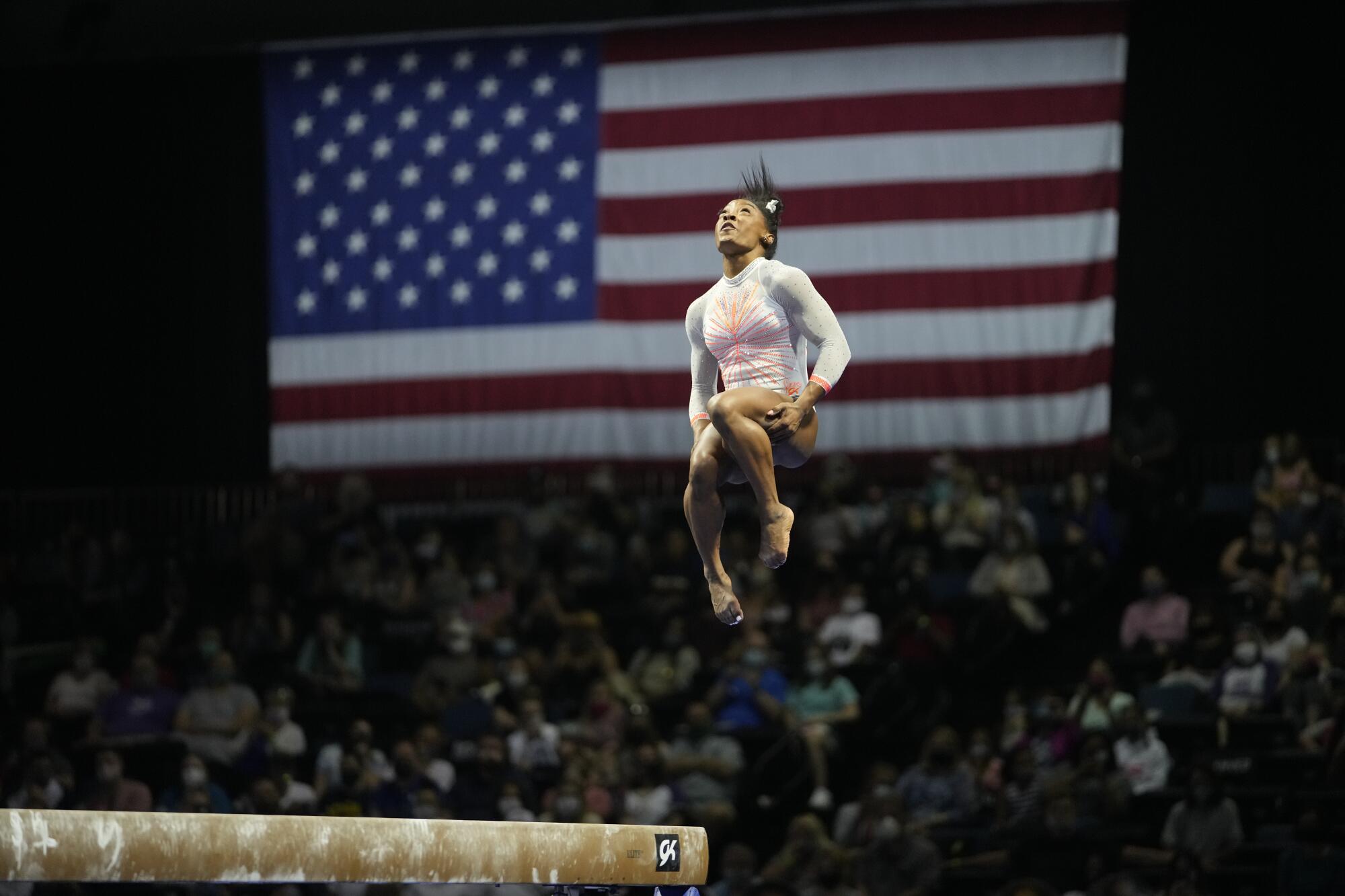
Waller believes Biles’ success stems from being aware of the mental and emotional strength she’d need to prevail at the elite level, where one wobble can wipe out years of work. Biles has prepared herself to perform and deliver under pressure, thriving where others might wilt.
“I know from conversations with her coaches that at a pretty young age she started working with sports psychologists to really help her develop her competitive skill,” Waller said. “I think a lot of people are simply going to point to her physical talent, but the reality is talent without work doesn’t work.
“I can’t say enough about how much respect I have for what she has done to be basically the ultimate professional athlete.”
Biles’ path to that peak often was difficult. She was born in Columbus, Ohio, to an alcohol- and drug-addicted mother who couldn’t care for her or her siblings. They lived in foster care until her maternal grandfather, Ron, and his wife, Nellie, adopted Simone and her younger sister Adria and brought them to live in Spring, Texas. She calls Ron and Nellie Mom and Dad. They shared her dreams, dried her tears, gave her the stability she craved and took her to gym classes to provide an alternative to jumping off their furniture at home.
Gymnastics was an ideal outlet for her boundless energy. She rose through the ranks quickly, barely missing a spot on the national team in 2011. Seeing another Black woman, Gabby Douglas, win the 2012 Olympic all-around gold medal inspired her to broaden her horizons. “I was super-excited because it was somebody who looked just like me, and I felt like if she could do it, I could do it one day,” Biles recalled a few years ago.
She loved the sport, but it didn’t always love her back, and she felt stifled under the rigid regime of national team coordinator Martha Karolyi. Sadly, that wasn’t the worst of it: In 2018 Biles came forward to acknowledge she was among the hundreds of girls and women who had been sexually abused by former national team doctor Lawrence Nassar, who had access to them under the guise of performing therapy. His misdeeds went unchecked while — and because — the American women consistently won medals on the international stage.
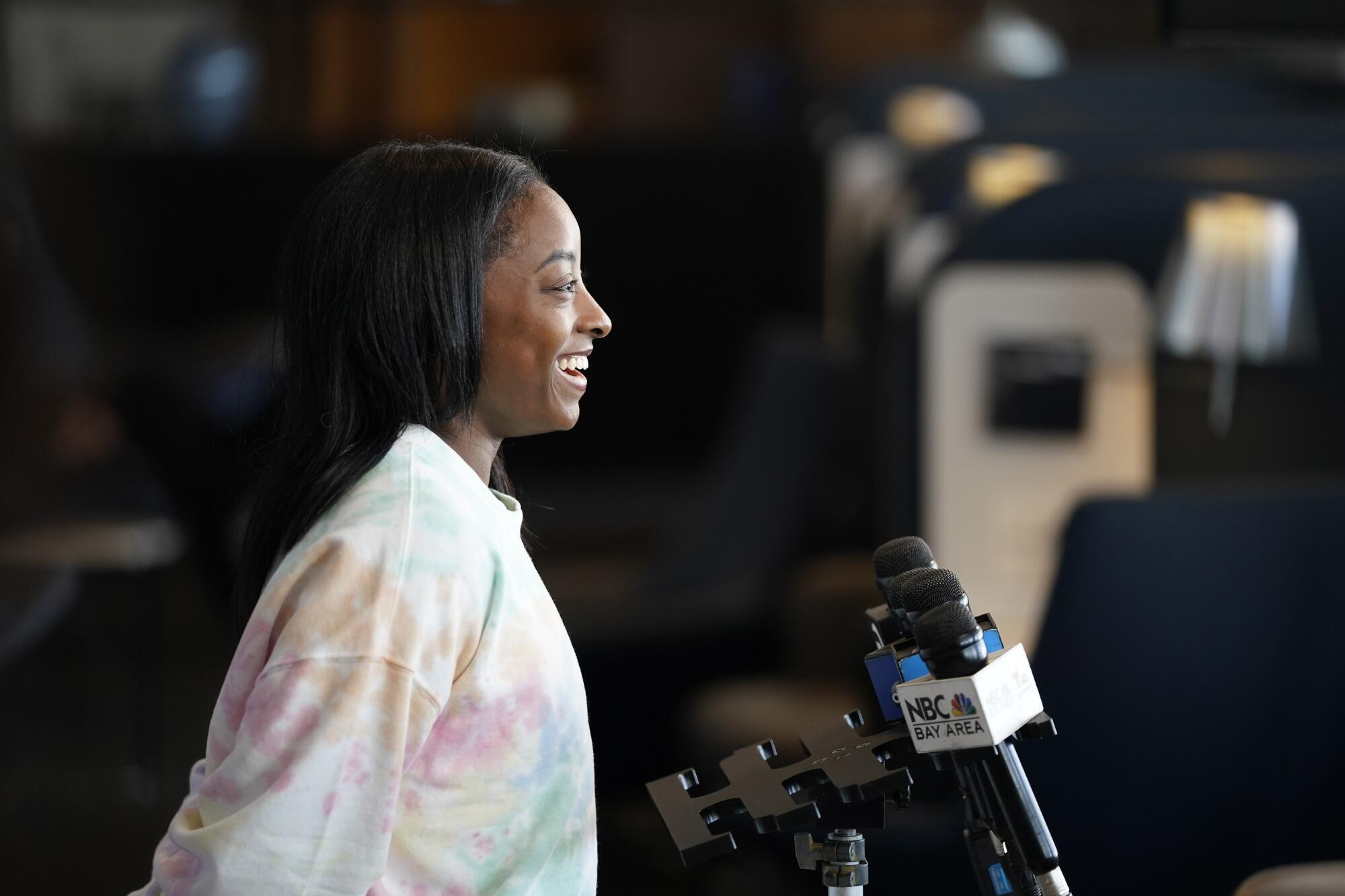
In “Simone vs. Herself,” a recent Facebook Watch series, Biles spoke of feeling depressed as she came to terms with what had happened. “I remember being on the phone with my agent and I remember telling my mom and my agent that I slept all the time and it’s because sleeping was basically better than offing myself,” she said. “It was my way to escape reality. Sleeping was like the closest thing to death for me at that point, so I just slept all the time.”
It was a wrenching admission, one she suppressed for years and refused to discuss with friends or family until she simply had to get her truth out. “I went through a whirlwind of emotions during that time,” she said in 2019. “It’s not easy. We all deal with it differently, but afterward I felt relieved, and I felt like I could help other females or other athletes come out about their stories and not be afraid to …” At that point she paused to regain her composure.
“Holding that to myself was really tough, but once I spoke out about it, it was kind of like a weight off my shoulders,” she added.
She has been critical of USA Gymnastics — the sport’s national governing body — for not adequately protecting athletes from predators like Nassar, who was sentenced to 40 to 175 years in prison for criminal sexual conduct. Biles’ voice carries far and wide and has substantial impact when she demands that USA Gymnastics be held accountable for its grievous mistakes and ensure such predators are weeded out of the sport’s ecosystem in the future. That will be part of her legacy too.
“She’s not afraid to call out USA Gymnastics or the International Olympic Committee when she thinks they’re doing wrong. She’s just a rock star. She’s not afraid. It’s really admirable,” Conner said. “I think she’s leading this empowerment movement for Olympic athletes. She’s earned a platform and she has handled that exceptionally well.”
She’s well-suited to bring about change at USA Gymnastics after she hangs up her leotard, but she’s also intrigued by the idea of becoming a volunteer college coach. After Tokyo, she will headline the 35-city Gold Over America Tour (there’s that GOAT again), a show that will showcase and celebrate female athletes. She also has a gym to run and an array of endorsement obligations to fulfill. “My presence in gymnastics will be here for a very long time,” she said.
Enjoy and appreciate her presence now, while she’s still soaring and tumbling and testing the pull of gravity and taking us all along for a thrill ride.
More to Read
Go beyond the scoreboard
Get the latest on L.A.'s teams in the daily Sports Report newsletter.
You may occasionally receive promotional content from the Los Angeles Times.

